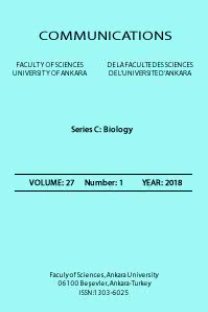THE ALLERGENIC POLLEN IN THE ATMOSPHERE OF EL-HADJAR CITY (ANNABA, ALGERIA)
Aeropalynology, allergenic pollens, atmospheric pollens, El-Hadjar region (Algeria)
___
M. Thibaudon and G. Olivier, Pollinoses et surveillance des pollens en France. Air Pur, 71 (2), (2007) 10-16.M.C. Kopferschmirt-Kubler and G. Pauli, Pollens et pollution. Revue Francaise d'Allergologie, 39 (4), (1999) 283–288.
G. D’Amato, Pollen allergy in the Mediterranean area. Revue Francaise d'Allergologie, 38 (7), (1998) 160–162.
B. Clot, Impact du réchauffement climatique sur le risque d’exposition aux allergènes environnementaux et aux pollens. Médecine et enfance, (2008) 141–145.
General Directorate of Forestry, La Direction Générale des Forêts de la Wilaya d’Annaba (2013).
L. Ketfi, Etude aéropalynologique de la région d’El-Hadjar. Mémoire de Magister: Université Badji Mokhtar, Annaba. (1998) 123 p.
O. C. Durham, The volumetric incidence of atmospheric allergens. IV. A proposed standard method of gravity sampling, counting and volumetric interpolation of results. Journal of Allergy, 17 (2), (1946) 79–86.
J. Charpin, R. Surinyach, & A.W. Frankland, Atlas of European allergenic pollens. Paris: Ed. Sandoz, (1974) 131–141.
M. Reille, Pollen et spores d’Europe et d’Afrique du (Nord ed.). France: Laboratoire de Botanique Historique et Palynologie. Univ. d’Aix-Marseille III., (1992) 543 p.
- ISSN: 1303-6025
- Yayın Aralığı: Yılda 2 Sayı
- Başlangıç: 1943
- Yayıncı: Ankara Üniversitesi
ANTIOXIDANT AND PHYSICOCHEMICAL PROPERTIES OF CHESTNUT HONEYS FROM TURKEY
CHANGES OF ARTEMISIA POLLEN CONCENTRATION IN ZONGULDAK ATMOSPHERE
Şenol ALAN, Tuğba SARIŞAHİN, Ayşe KAPLAN
ANTIMICROBIAL ACTIVITIES OF SOME BRYOPHYTES IN TURKEY
Şenol ALAN, Ferudun KOÇER, Güray UYAR
DIFFERENTIATION OF THERMAL PROPERTIES OF POLLENS ON GENUS LEVEL
Muhammad MUJTABA, Murat KAYA, Talip CETER
CHEMICAL COMPOSITION AND ANTIOXIDANT ACTIVITY OF SEVEN DIFFERENT GRAPE EXTRACTS
Laila Radwan Abdalla ELFOGOHI, Haafize Dilek TEPE, İdris YAZGAN, Talip CETER
COMPARATIVE POLLEN MORPHOLOGY STUDIES OF TWO ENDEMIC NOCCAEA MOENCH (BRASSICACEAE) TAXA FROM TURKEY
Kurtuluş OZGISI, Onur KOYUNCU, Okan SEZER, Derviş OZTURK, Atila OCAK, O.koray YAYLACI, İsmühan POTOĞLU ERKARA
SPORE MORPHOLOGY OF SOME BARTRAMIACEAE SPECIES (BRYOPHYTA) IN TURKEY
Talip CETER, Merve CAN GÖZCÜ, Güray UYAR
BIOLOGICAL AIRBORNE PARTICLES IN KIRSEHIR ATMOSPHERE EXCEPT FOR POLLEN AND FUNGAL SPORES
ALLERGENIC COMPOUNDS IN HONEY BEE PRODUCTS
EFFECTS OF GLOBAL-WARMING AND CLIMATE-CHANGES ON ATMOSPHERIC FUNGI SPORES DISTRIBUTION
